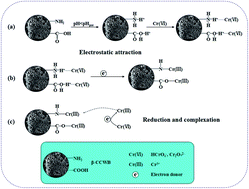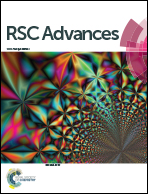Effective removal of Cr(vi) using β-cyclodextrin–chitosan modified biochars with adsorption/reduction bifuctional roles
Abstract
In this work, beta-cyclodextrin–chitosan modified walnut shell biochars (β-CCWB) were synthesized as a low-cost adsorbent for the removal of heavy metal Cr(VI) from aqueous solutions. Batch sorption experiments were carried out to investigate the adsorption characteristic of β-CCWB. The experimental data fitted a pseudo-second order equation and Freundlich isotherm model, and the optimum adsorption of the modified biochar was observed at pH 2.0 with an adsorption capacity of 206 mg g−1. Thermodynamic analysis showed that the adsorption process was spontaneous and endothermic. The removal efficiency of Cr(VI) by β-CCWB (about 93%) was higher than that by the pristine biochar (about 27%). Characteristic analysis indicated that amino and carboxyl groups were the major functional groups for Cr(VI) sorption, and implied that the electrostatic attraction of Cr(VI) to the positively charged biochar surface, reduction of Cr(VI) to Cr(III) ions and the complexation between Cr(III) ions and β-CCWB functional groups were responsible for Cr(VI) removal mechanism in this research. Furthermore, the environmentally friendly and low-cost β-CCWB could be applied as a potential effective adsorbent to remediate Cr(VI) contamination from aqueous solution.

- This article is part of the themed collection: Removal of chromium from aqueous solutions

 Please wait while we load your content...
Please wait while we load your content...